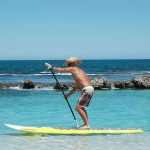Even a seasoned pro can be baffled by the range of paddle boards on the market! How much paddleboard costs can be so confusing.
The prices for this product range from $200 to $3000, so you can’t expect much in terms of quality. Is it even ‘that big of a deal? You bet it is!
In this section, I will explain in detail what you can expect in terms of the cost of a paddle board.
How Much Does a Good Paddle Board Cost?
Define good. What are your expectations for your paddle board? Will you paddle every day of the year, or will you only paddle 18 days out of the year? What activity would you like to do on the water? Or all of the above?
What you want to do with your paddle board and how often you’ll use it will have a big impact on what kind of paddle board prices would work for you.
In the end, it all depends on your budget and what you’re comfortable spending.
Now that that is out of the way, let’s get to the first distinction between types of paddle boards: those made of epoxy, and those that are inflatable.
Epoxy paddle board cost
The type of paddle board will determine the price. The epoxy-made paddle boards tend to cost the most. The prices of the products range from $700 to $3000 because they are the most demanding to make and ship.
When you own a surfboard, you should think about how you will store and transport it. You need a large enough space to store your paddleboard, as well as a rack that won’t damage it and will keep it safe.
Many people only shy away from hard boards because of this reason.
The boards have a foamy core made of EPS, with layers of fiberglass in between, all held together with epoxy resin. Thanks to their rigidity, these types of construction offer the best performance in all water conditions.
Epoxy Paddle Board Cost: $700 To $1,200
However, not all epoxies are made the same. The least expensive options are the most versatile and offer the most variety for a beginner.
There are many different activities that you can do on a paddle board, such as surfing, yoga, leisure paddling, and fishing.
Remember that just because a paddle board is low-cost, it doesn’t mean it’s made with lower quality or less functional materials. They are a great choice for beginners who want to try paddling and other activities without spending a lot of money.
After you have gained some experience and feel confident enough to improve, you will need to get new gear or replace your board.
The large surface area of these boards provides increased stability for any activity you want to try.
Epoxy Paddle Board Cost: $1,300 To $2000+
If you want a faster, more maneuverable board with better performance, you should look for a board in this price range.
More expensive boards will be specialized in just one thing. This means you cannot use your yoga board to surf or fish.
But what makes these boards more expensive?
The reason these boards cost more is because they are made with carbon fiber, which makes them stronger and more durable. The shapes of the boards make it easier to surf and paddle, with a faster and smoother glide.
It is not a rip-off to spend $1700 or more on a surfboard. When choosing a product, it is important to consider how well it will perform in the long run.
Factors such as stability, durability, and overall performance are important to consider in order to make sure you are getting a product that is worth your investment.
Inflatable paddle board cost
The price of a paddle board depends on whether it is inflatable or epoxy. Inflatable paddle boards are less expensive, but they are not as durable or perform as well as epoxy paddle boards.
Most inflatable paddle boards come with a package that includes everything you need. They’ll always have a hand-pump, a backpack for storage and a repair-kit with them. Some leashes come with an ankle leash, but you should always check the contents of the package before purchase.
Inflatable Paddle Board Prices: $500 or Below
The following text discusses the cheapest boards available, which start at $300. These boards are good for beginners. Even though they are cheaper, the stability and durability of the boards in the pricier categories is better. A board in this price range would be good for paddling alongside children.
If you’re an adult who likes to paddle or surf, you’ll be disappointed with these low-end boards.
This is a situation where the saying “you get what you pay for” is accurate.
The performance of a material is greatly influenced by its composition. Cheaper Boards lack the necessary rigidity due to the fact that they use 1 to 2 layers of PVC instead of the usual amount. So, they might deflate or bend or are unstable.
Inflatable Paddle Board Prices: $600 To $800
If you are looking for a board within a certain price range, I would recommend this one. I wouldn’t suggest going for the low-range boards for first-time buyers who know they’ll be paddling more regularly.
The mid-range price of $600 to $800 is ideal for newbies because it is affordable and still allows you to get a good quality product.
The vehicles will be durable and have good performance. It’s important to pick the right size bike for your height, weight, and activity level.
If you paddle in this way, you will be able to more easily learn balance and stability, as well as being able to control your board no matter where you are paddling.
Inflatable Paddle Board Prices: $900 To $1,600
Paddle boards that cost around this much are usually of high quality, and you generally won’t find any that cost more than this amount (although Red Paddle Co. tends to break this rule).
If you purchase a board within this price range, you can be confident that it will be durable and able to withstand being used in water frequently.
The brand will determine what additional gear, if any, comes with the board. The board will be specialized for the activity you’ll be using it for, just like with the high-end epoxy boards.
These boards also offer excellent performance and easy control while in the water, just like the high-end epoxy boards.
The high price is due to the costly material. These boards are made of multiple layers of PVC, which gives them rigidity and smoothness when in water.
The PVC materialused in inflatable boards makes them look and perform like epoxy ones, without bending or flexing.
Does Cost Tell You Anything About Quality?
How much a paddle board costs is not as simple to answer as one might think. A more important question to ask might be if you get what you pay for when you purchase a paddle board.
The Tower Paddle Boards Chris Craft edition ISUP was named the #1 SUP board worldwide by the prestigious Robb Report in 2017, beating out competing brands’ boards that were priced as high as $3,399.
This board was priced at $1,785, which was in the same range as the five boards featured from well-known brands like Naish and Starboard. It’s not surprising that our board was the only inflatable SUP in this top five ranking since it’s more affordable than the hard-top SUPs.
The Tower Chris Craft edition was sold for $649, which is much lower than the $1,785 price that it would likely go for in a retail store. While the Chris Craft edition ISUP is one of the best in the world, it is much cheaper than the most expensive board in that group.
Tower Paddle Boards was founded to provide more affordable paddle boards. The company’s Owner went shopping for a paddle board in 2010 and was surprised by how expensive they were. An all-around paddle board from a retail store would cost around $1,200 to $1,600 for a basic beginner board, which is similar to an oversized surfboard.
Why are paddle boards so expensive when you can buy a surfboard for much less?
He realized that SUP boards could be produced cheaply and then sold directly to consumers for much less than the price of retail brands.
Tower Paddle Boards was created, and the consumer-direct business model took over the stand-up paddle board market. In the year 2011, Tower was one of the first companies to produce inflatable paddle boards that were 6 inches thick.
This changed the market because inflatable SUPs went from being less than 1% of the market to more than 70% in a span of 5 years. Selling both traditional hard SUPs and ISUPs directly to consumers at half the price of comparable retail boards, we quickly became an industry leader.
After two years of rapid growth, Tower was named a top 5 brand worldwide in the SUP market in 2016.
Paddle Board Cost Myth-Busting
We are familiar with the paddle board market and what drives the costs. In 2013, the founder of Fast Company wrote an article about price-fixing in the paddle board industry. If you try to find out how much paddle boards cost by searching the internet, you will probably find a lot of inaccurate information.
There is a lot of misinformation about paddle board prices online, from shady affiliate marketers to people and SUP brands who deliberately give false information. The main point of this false information is that people believe that you get better quality when you spend more money on a product.
However, that is not always the case in today’s market. It’s not true that today’s stand-up paddle boards are all expensive.
Sales Channel Affects Paddle Board Pricing the Most
There is a lot of variation in the price of stand-up paddle boards, with some costing as little as $200 while others costing as much as $3,000.
The phrase “you get what you pay for” suggests that cheaper products are of lower quality, while more expensive products are only necessary for special purposes.
Therefore, it is advisable to purchase a paddle board that falls somewhere in the middle price-wise. That sounds good, but it’s baloney. The average cost of a paddle board is not determined by the quality of the product, but by the sales channel and the intentional price positioning of the brand.
Direct-to-Consumer SUP Pricing
Another major factor that is disrupting the retail ecosystem is direct-to-consumer-only brands, also called “DTC brands.” They are disrupting every industry.
High-profile brands like Warby Parker, Allbirds, and Tesla are offering better-quality products and better prices by selling directly to consumers. No middlemen are involved in direct-to-consumer commerce. The tower sold paddle boards to consumers for half the cost of a comparable SUP board at retail. The reason they have been successful and why their paddle boards are in high demand globally is because…
If a paddle board costs $350 to produce, they can sell it directly to consumers for a one-time markup.
A retail store’s paddle board price is three to five times the production cost, and Amazon takes 50% of anything sold through its marketplace. In order to maintain profitability and sustain their brand in the long term, they only have to charge a little bit more for their products than it costs to produce them.




